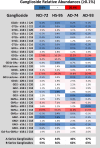Region-specific quantitation of glycosphingolipids in the elderly human brain with Nanoflow MEA Chip Q/ToF mass spectrometry
- PMID: 40207879
- PMCID: PMC12021261
- DOI: 10.1093/glycob/cwaf022
Region-specific quantitation of glycosphingolipids in the elderly human brain with Nanoflow MEA Chip Q/ToF mass spectrometry
Abstract
Glycosphingolipids are a unique class of bioactive lipids responsible for lateral membrane organization and signaling found in high abundance in the central nervous system. Using nanoflow MEA Chip Q/ToF mass spectrometry, we profiled the intact glycosphingolipids of the elderly human brain in a region-specific manner. By chromatographic separation of glycan and ceramide isomers, we determined gangliosides to be the highest source of heterogeneity between regions with the expression of a- and b-series glycan structures. Investigation of these trends showed that specific glycan structures were, in part, determined by the structure of their lipid backbone. This study provides insight into the dynamic process of membrane remodeling in the brain during aging.
Keywords: MEA Chip; Nanoflow HPLC-Q; ToF; brain map; glycosphingolipids.
© The Author(s) 2025. Published by Oxford University Press.
Conflict of interest statement
None declared.
Figures







Similar articles
-
Intact glycosphingolipidomic analysis of the cell membrane during differentiation yields extensive glycan and lipid changes.Sci Rep. 2018 Jul 20;8(1):10993. doi: 10.1038/s41598-018-29324-7. Sci Rep. 2018. PMID: 30030471 Free PMC article.
-
Database and data analysis application for structural characterization of gangliosides and sulfated glycosphingolipids by negative ion mass spectrometry.Carbohydr Res. 2014 Dec 5;400:1-8. doi: 10.1016/j.carres.2014.06.029. Epub 2014 Jul 10. Carbohydr Res. 2014. PMID: 25299937
-
Negative ion fast atom bombardment mass spectrometry of gangliosides and asialo gangliosides: a useful method for the structural elucidation of gangliosides and related neutral glycosphingolipids.J Biochem. 1983 Jul;94(1):249-56. doi: 10.1093/oxfordjournals.jbchem.a134336. J Biochem. 1983. PMID: 6619111
-
Gangliosides and glycosphingolipids of peripheral nervous system myelins--a minireview.Neurochem Res. 1998 Mar;23(3):305-10. doi: 10.1023/a:1022497114813. Neurochem Res. 1998. PMID: 9482242 Review.
-
Neurological analyses: focus on gangliosides and mass spectrometry.Adv Exp Med Biol. 2014;806:153-204. doi: 10.1007/978-3-319-06068-2_8. Adv Exp Med Biol. 2014. PMID: 24952183 Review.
References
-
- Boggs JM, Gao W, Hirahara Y. 2008. Myelin glycosphingolipids, Galactosylceramide and Sulfatide, participate in carbohydrate–carbohydrate interactions between apposed membranes and may form Glycosynapses between oligodendrocyte and/or myelin membranes. Biochim Biophys Acta (BBA). 1780:445–455. - PubMed
MeSH terms
Substances
Grants and funding
LinkOut - more resources
Full Text Sources
Medical

